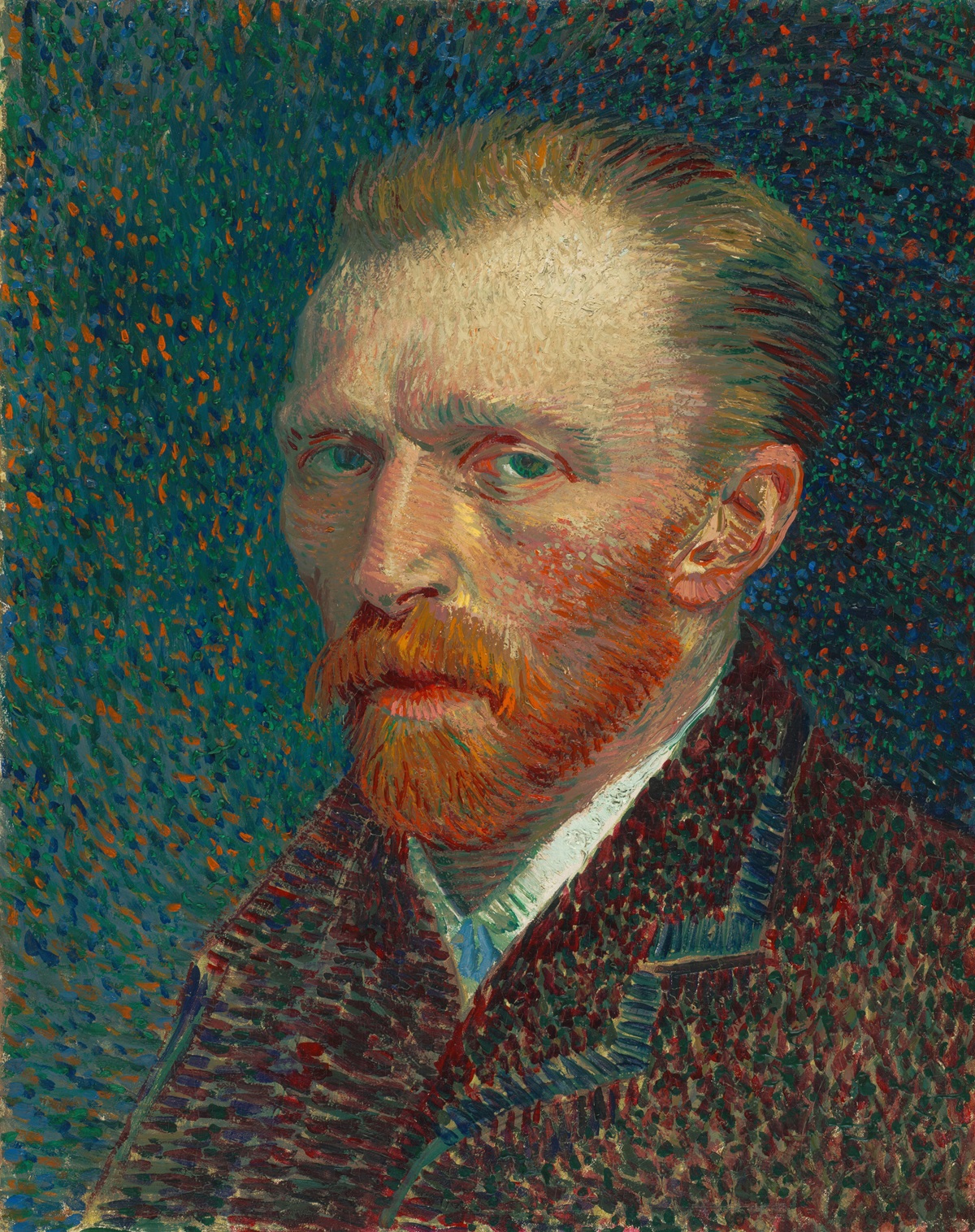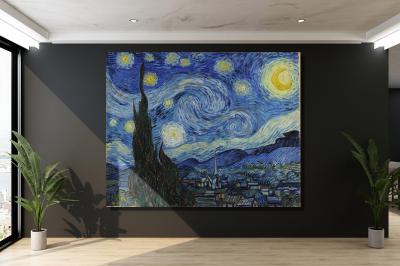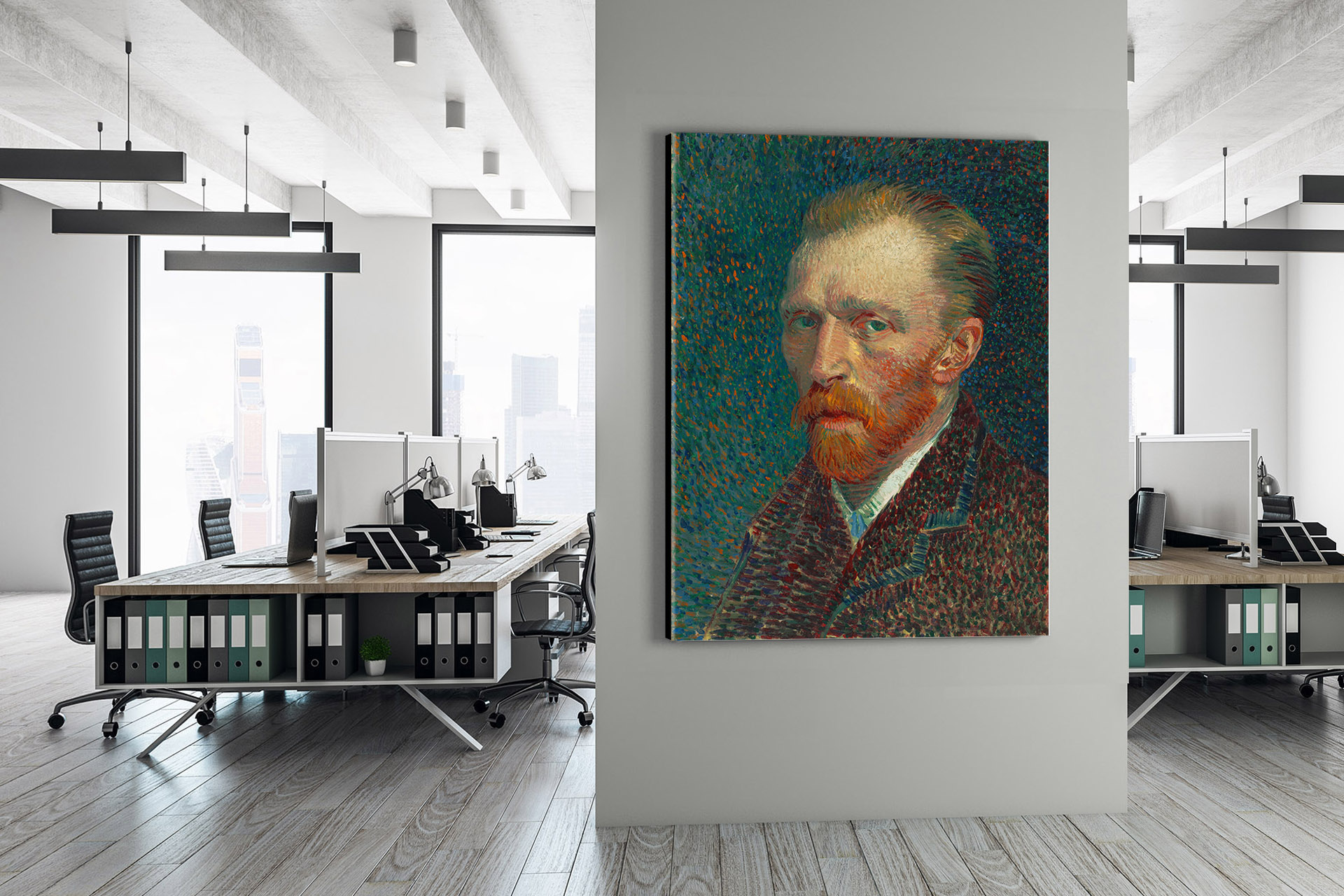Van Gogh Self Portrait
By Vincent van Gogh, 1887
Vincent van Gogh’s Self-Portrait: A Profound Exploration of Tormented Genius
Vincent van Gogh, the renowned Dutch Post-Impressionist painter, left behind a treasure trove of art that continues to resonate with art enthusiasts worldwide. Among his numerous masterpieces, one painting stands out as a poignant and captivating self-exploration: the “Van Gogh Self-Portrait.” This iconic self-portrait transcends mere representation, offering us a window into the turbulent psyche and unparalleled creative genius of the artist. In this in-depth exploration, we delve into the history, symbolism, technical challenges, the location of the painting, and the enigmatic artist behind this mesmerizing masterpiece.
A Window into Van Gogh’s Turbulent World
Vincent van Gogh’s Self-Portrait, painted in 1889, is a testament to his unwavering commitment to the art of self-expression. Unlike many other artists, van Gogh created an extensive collection of self-portraits throughout his career, totaling over 30 in number. These self-portraits provide an intimate look into the artist’s tumultuous life, allowing us to witness the evolution of his style and the progression of his mental state.
The “Van Gogh Self-Portrait” is distinctive for several compelling reasons. It was created during a pivotal period in the artist’s life when he sought refuge at the Saint-Paul-de-Mausole asylum in Saint-Rémy-de-Provence, France. This chapter was marked by both immense creativity and personal torment. Van Gogh voluntarily admitted himself to the asylum, yearning for respite from his mental struggles and hoping to find solace in his art. During his stay, he produced some of his most iconic works, with the self-portrait being a central piece in this extraordinary puzzle.
“Van Gogh Self Portrait” Large Canvas Prints from WhiteClouds
Symbolism and Profound Self-Reflection
This self-portrait is a poignant manifestation of van Gogh’s profound introspection, offering an unfiltered glimpse into his emotional turmoil. In the painting, the artist presents himself with an almost unsettling intensity. His piercing blue eyes, framed by fiery orange hair and a copper beard, seem to pierce through the confines of the canvas, reaching out to touch the viewer’s soul. The swirling, tumultuous background hints at the emotional maelstrom within his troubled mind.
The choice of colors in the self-portrait is striking and meaningful. Van Gogh’s use of vibrant and contrasting hues, including cobalt blue, emerald green, and sunflower yellow, creates a powerful contrast with the melancholic expression on his face. These complementary colors accentuate the discord between his external appearance and internal struggles, amplifying the emotional impact of the artwork.
The Bandaged Ear: A Haunting Reminder
One of the most haunting elements of the “Van Gogh Self-Portrait” is the bandaged ear, a symbol laden with significance. It serves as a poignant reminder of van Gogh’s notorious self-mutilation incident, which occurred prior to his stay at the asylum. The bandage on his ear is not just a physical detail but a profound symbol of his suffering and the fragility of his mental state. It seems to convey a message: “I bear my scars proudly; they are part of who I am.”
Deciphering the Enigmatic Background
The enigmatic background of the self-portrait has intrigued art historians for generations, sparking various interpretations. Some believe it represents van Gogh’s inner turmoil, reflecting the emotional storms that raged within him. Others see it as a visual manifestation of the artist’s deep fascination with the cosmos and the mysteries of the universe. Van Gogh had an abiding love for nature and often sought solace in its beauty, even during his time at the asylum. The swirling patterns might also allude to the idea of a whirlwind of thoughts and emotions, a tempestuous mental landscape that the artist wrestled with throughout his life.
Technical Challenges and Location
Vincent van Gogh’s “Van Gogh Self-Portrait” posed several technical challenges that showcased his artistic prowess. The intricate details of his facial features, especially the intricate interplay of light and shadow on his beard and the wrinkles on his forehead, reveal the artist’s mastery of capturing the human form. The vibrancy of the colors used in the portrait, combined with the swirling background, showcases his ability to infuse his emotions into his work, creating a vivid and emotionally charged piece.
The location of this renowned self-portrait adds another layer of significance to its story. Painted during van Gogh’s stay at the Saint-Paul-de-Mausole asylum in Saint-Rémy-de-Provence, France, the artwork captures the essence of the surroundings that influenced him. The tranquil yet haunting atmosphere of the asylum’s surroundings and the beautiful Provençal landscape undoubtedly left an indelible mark on his work. It was in this environment that van Gogh found inspiration amidst his struggles, and this self-portrait stands as a testament to his ability to channel his inner turmoil into art.
The Enigmatic Artist: Vincent van Gogh
Vincent van Gogh was born on March 30, 1853, in Groot-Zundert, Netherlands, into a family of art dealers. Despite a tumultuous life marked by mental health challenges and financial hardships, van Gogh’s passion for art burned brightly. He began his artistic journey as a self-taught artist, forging a unique style characterized by bold colors, expressive brushwork, and emotional intensity.
Throughout his short but prolific career, van Gogh created over 2,000 artworks, including paintings, drawings, and sketches. His artistic evolution is a testament to his relentless pursuit of self-improvement and creative exploration. Van Gogh was deeply influenced by the Impressionists, but he moved beyond their style, developing a distinctive Post-Impressionist approach that laid the foundation for modern art movements.
Tragically, van Gogh’s mental health deteriorated over the years, leading to episodes of severe depression and erratic behavior. Despite these challenges, he continued to create art, using it as a means to understand and express his innermost emotions. His dedication to art and his unwavering commitment to self-expression continue to inspire artists and art lovers alike.
 Van Gogh Self Portrait
Van Gogh Self Portrait
Conclusion
Vincent van Gogh’s “Van Gogh Self-Portrait” is a masterpiece that transcends the boundaries of time and space. It offers a profound glimpse into the mind of a tormented genius who laid bare his heart and soul on the canvas. Through vivid colors, haunting symbolism, technical brilliance, and an intense exploration of self, van Gogh invites us to share in his pain, passion, and creativity.
As we immerse ourselves in the intricacies of this self-portrait, we are reminded of the enduring power of art to transcend suffering and connect us with the human experience. Vincent van Gogh’s self-portrait continues to inspire and captivate, serving as an eternal testament to the indomitable spirit of the artist, the timeless allure of his work, and the technical brilliance that underpins his enduring legacy. It stands as a confirmation to the resilience of the human spirit in the face of adversity, encouraging us all to confront our own inner turmoil with courage, creativity, and the transformative power of art.
Frequently Asked Questions About “Van Gogh Self Portrait”
“Van Gogh Self Portrait” by Vincent van Gogh is a captivating artwork that often sparks curiosity and interest. Here are some frequently asked questions about this iconic self-portrait:
When and where was the “Van Gogh Self Portrait” painted? This self-portrait was painted in 1889 while Vincent van Gogh was staying at the Saint-Paul-de-Mausole asylum in Saint-Rémy-de-Provence, France.
Why did Vincent van Gogh paint so many self-portraits? Van Gogh created over 30 self-portraits throughout his career as a way to practice and explore his artistic skills, and also because he had limited access to models and subjects.
What is the significance of the bandaged ear in the self-portrait? The bandaged ear in the self-portrait is a reference to van Gogh’s notorious act of self-mutilation, when he cut off part of his ear. It serves as a symbol of his personal suffering and mental turmoil.
What is the symbolism behind the swirling background? The swirling background in the self-portrait is open to interpretation. Some believe it represents van Gogh’s inner turmoil, while others see it as a reflection of his fascination with the cosmos and the mysteries of the universe.
What was van Gogh’s mental state when he painted this self-portrait? Vincent van Gogh painted this self-portrait during a period of mental instability while he was voluntarily admitted to the asylum. His mental state was marked by both creativity and personal torment.
How many self-portraits did Vincent van Gogh create in total? Vincent van Gogh created over 30 self-portraits during his lifetime, showcasing his evolution as an artist and his changing mental state.
Where is the “Van Gogh Self Portrait” currently located? The “Van Gogh Self Portrait” is part of the collection at the Musée d’Orsay in Paris, France.
What makes this self-portrait unique compared to van Gogh’s other self-portraits? This self-portrait is unique because it was created during a pivotal period in van Gogh’s life when he was at the asylum in Saint-Rémy. It captures a moment of intense introspection and self-expression.
What materials and techniques did van Gogh use to create this self-portrait? Vincent van Gogh typically used oil paints on canvas for his self-portraits. His technique involved bold, expressive brushwork and the use of vibrant, contrasting colors.
How has the “Van Gogh Self Portrait” influenced the art world? This self-portrait, along with van Gogh’s other works, has had a profound impact on the art world, influencing subsequent generations of artists. It is celebrated for its emotional depth, vibrant colors, and powerful self-exploration.
These frequently asked questions provide insight into the fascination and curiosity that surrounds Vincent van Gogh’s “Van Gogh Self Portrait” and its enduring significance in the world of art.
Other Articles on Vincent van Gogh Paintings
At Eternities Gate by Vincent Van Gogh, 1890
Blossoming Almond Tree by Vincent Van Gogh, 1890
Cafe Terrace at Night by Vincent Van Gogh, 1888
Daubigneys Garden by Vincent Van Gogh, 1890
Green Wheat Field with Cypress by Vincent Van Gogh, 1889
Houses at Auvers by Vincent Van Gogh, 1890
Irises by Vincent Van Gogh, 1889
Night Café by Vincent Van Gogh, 1888
Portrait of Dr. Gachet by Vincent Van Gogh, 1890
Red Vineyards by Vincent Van Gogh, 1888
Road with Cypress and Star by Vincent Van Gogh, 1890
Starry Night by Vincent Van Gogh, 1889
Starry Night over the Rhone by Vincent Van Gogh, 1888
Sunflowers by Vincent Van Gogh, 1887
The Bedroom by Vincent Van Gogh, 1888
The Church at Aurers by Vincent Van Gogh, 1890
The Garden of the Asylum by Vincent Van Gogh, 1889
The Mulberry Tree by Vincent Van Gogh, 1889
The Potato Eaters by Vincent Van Gogh, 1885
The Yellow House by Vincent Van Gogh, 1888
Tree Roots by Vincent Van Gogh, 1890
Van Gogh Self Portrait by Vincent Van Gogh, 1887
Vase with Red Poppies by Vincent Van Gogh, 1886
View of Arles by Vincent Van Gogh, 1889
Wheat Field with Crows by Vincent Van Gogh, 1890
Wheat Field with Cypresses by Vincent Van Gogh, 1889
More WhiteClouds Videos
Contact us today to learn more about our 3D services and how we can help you achieve your goals.

